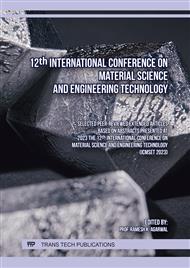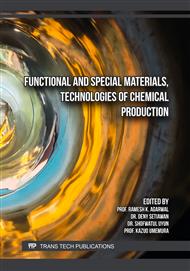[1]
Sheng, J.J.: A Comprehensive Review of AlNaline-Surfactant-Polymer (ASP) Flooding. In: SPE Western Regional & AAPG Pacific Section Meeting 2013 Joint Technical Conference, Monterey, California, USA. Usman, Iskandar, UP, Sugihardjo, and Lastiadi, H (2014).
Google Scholar
[2]
Ulasbek, K., Hashmet, M.R., Pourafshary, P., Muneer, R.: Laboratory Investigation of Nanofluid-Assisted Polymer Flooding in Carbonate Reservoirs. Nanomaterials. 12, 4258 (2022).
DOI: 10.3390/nano12234258
Google Scholar
[3]
Shakeel, M., Samanova, A., Pourafshary, P., Hashmet, M.R.: Experimental analysis of oil displacement by hybrid engineered water/chemical EOR approach in carbonates. J. Pet. Sci. Eng. 109297 (2021).
DOI: 10.1016/j.petrol.2021.109297
Google Scholar
[4]
Karimov, D., Hashmet, M.R., Pourafshary, P.: A laboratory study to optimize ion composition for the hybrid low salinity water/polymer flooding. In: Offshore Technology Conference Asia. OnePetro (2020).
DOI: 10.4043/30136-ms
Google Scholar
[5]
Hashmet, M.R., Qaiser, Y., Mathew, E.S., AlAmeri, W., AlSumaiti, A.M.: Injection of polymer for improved sweep efficiency in high-temperature high salinity carbonate reservoirs: Linear X-ray aided flood front monitoring. In: SPE Kingdom of Saudi Arabia Annual Technical Symposium and Exhibition. OnePetro (2017).
DOI: 10.2118/188125-ms
Google Scholar
[6]
Firozjaii, A.M., Saghafi, H.R.: Review on chemical enhanced oil recovery using polymer flooding: Fundamentals, experimental and numerical simulation. Petroleum. 6, 115–122 (2020).
DOI: 10.1016/j.petlm.2019.09.003
Google Scholar
[7]
Kulawardana, E.U., Koh, H., Kim, D.H., Liyanage, P.J., Upamali, K.A., Huh, C., Weerasooriya, U., Pope, G.A.: Rheology and transport of improved EOR polymers under harsh reservoir conditions. In: SPE improved oil recovery symposium. OnePetro (2012).
DOI: 10.2118/154294-ms
Google Scholar
[8]
Zhang, F., Yang, G., Liu, Y., Li, J.: Development of Chemical Oil Displacem net Agent for High Temperature and High Salinity Reservoir. Adv. fine petrochemicals. 6, 8–11 (2005).
Google Scholar
[9]
Sheng, J.: Modern chemical enhanced oil recovery: theory and practice. Gulf Professional Publishing (2010).
Google Scholar
[10]
Alfazazi, U., AlAmeri, W., Hashmet, M.R.: Screening of new HPaM base polymers for applications in high temperature and high salinity carbonate reservoirs. In: Abu Dhabi International Petroleum Exhibition & Conference. OnePetro (2018).
DOI: 10.2118/192805-ms
Google Scholar
[11]
Garrocuh, A.A., Gharbi, R.B.: A novel model for viscoelastic fluid flow in porous media. In: SPE Annual Technical Conference and Exhibition? p. SPE-102015. SPE (2006).
DOI: 10.2118/102015-ms
Google Scholar
[12]
Sagyndikov, M., Seright, R., Tuyakov, N.: An unconventional approach to model a polymer flood in the Kalamkas oilfield. In: SPE Improved Oil Recovery Conference. OnePetro (2022).
DOI: 10.2118/209355-ms
Google Scholar
[13]
M. Shakeel, P. Pourafshary, M. R. Hashmet, and R. Muneer, Application of machine learning techniques to predict the viscosity of polymer solutions for enhanced oil recovery, Energy Systems, 2023.
DOI: 10.1007/s12667-023-00635-7
Google Scholar



